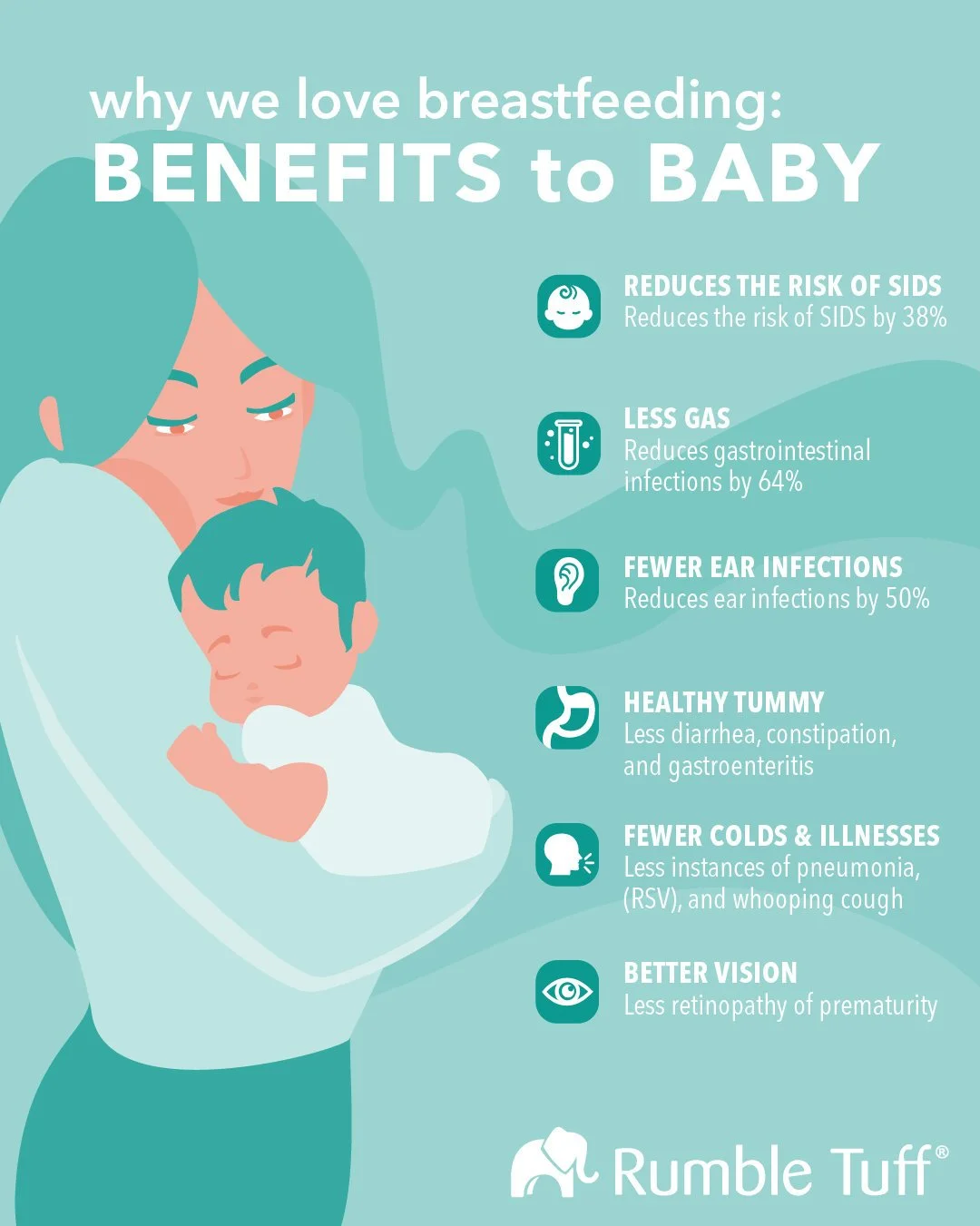
Why should you try breastfeeding?
And how?
Breastfeeding is not an easy job. It seems like the most natural thing in the world, since people have been doing it for centuries upon centuries – but most moms quickly realize this is not the case. And there’s no shame in having a hard time! There are many reasons why breastfeeding doesn’t work right away – and you are not to blame. This is especially true for low-income, minority women – as this demographic experiences the most barriers to breastfeeding, and the lowest breastfeeding rates. These women also tend to be disproportionately affected by negative health outcomes, which may improve with breastfeeding (Jones et al., 2015). There is often shame or a stigma associated with breastfeeding, and it feels like something that should be done in private, which makes it inconvenient (Santhanam, 2019). Leaking is also common and can be extremely embarrassing when out in public. Outside of the potential embarrassment, breastfeeding can also be painful (Santhanam, 2019). Women also have to balance returning to work – and low-income, minority women, in particular, tend to have less flexible work hours, which make nursing and pumping more difficult (Santhanam, 2019).
However, even in the face of all this adversity, breastfeeding is possible! With the right support and resources, and few tips and tricks, you can learn how to overcome these obstacles and have success breastfeeding! We’re here to be a resource if you decide to go this route.
Benefits of Breastfeeding
If you do decide to give breastfeeding a try, you will reap numerous benefits. Breastfeeding can help lower risk of many diseases, like type 2 diabetes, hypertension, hyperlipidemia, and cardiovascular disease (Jones et al., 2015). It can also help with weight loss, which can lower risk of additional health problems that come along with obesity (Jones et al., 2015). Additionally, women who don’t breastfeed are at a higher risk of breast and ovarian cancer (Stuebe, 2009). There are also benefits for baby, including a lowered risk of obesity during childhood, and protection against infections from the natural immunity components found in breast milk (Jones et al, 2015; Stuebe, 2009). Below you can find an infographic highlighting even more benefits for baby. This will all result in lowered health care and medical expenses for both mother and baby. There are also other economic benefits of breastfeeding. For example, food expenses are lower since you won’t have to buy formula (or as much formula) (The Mother and Child Health and Education Trust, 2016).
Daria’s Story
A recent new mother, Daria, spoke to us about her experience with breastfeeding. She expressed a lot of the same challenges outlined above, explaining that she had a really hard time with breastfeeding in the beginning. But Daria made a promise to herself that would continue trying to breastfeed her newborn for a year. She did research on different strategies to find what worked for her and her baby, and ultimately stuck it out. She achieved her goal of a year and felt very proud of herself for not giving up. She also reported feeling a strong connection with her baby and said she thought her baby didn’t get sick as often as some of her friends’ children.
We hope that Daria’s story gives you hope that breastfeeding, while difficult at times, can be done and will produce wonderful benefits for yourself and your baby.
Positioning & Latching
Below are a few tips on breastfeeding technique that may help if you’re experiencing any difficulty with positioning or latching (Schanler & Enger, 2018).
Positioning: When choosing a position, it is most important that you find one that is comfortable for both you and baby. Be sure to try different positions! This will help if you experience any discomfort or if the baby is having difficulty with feeding.
Here are three positions you can try: football position, sitting-up position, and side-lying position.
Latching: latching is key for successful breastfeeding. You’ll want to make sure that baby’s mouth covers as much of the areola as possible and forms a seal around the nipple.
Signs of a good latch include:
Their mouth is wide open, as if they are yawning.
Their lower lip is turned outward on the breast.
Their chin is touching the breast, with the nose also close to the breast.
Baby has full cheeks.
Their tongue sticks out over the lower lip during latch-on and stays below the areola while nursing.
It’s important to note that, while breastfeeding, you should be completely comfortable! You may feel some tugging, tingling, or pressure, but it should not be painful. If it is, make sure to readjust the baby’s latch (Schanler & Enger, 2018).
HERE is a short video that provides a nice overview on latch & positioning.
Additional Resources
Below are a few additional resources that may be helpful in your breastfeeding journey:
Le Leche League International: https://llli.org/
This is a great resource that provides educational materials and information, as well as various types of support and encouragement.
WIC: https://wicbreastfeeding.fns.usda.gov/
Similar to Le Leche League International, WIC’s aim is to help give moms the resources and support they need to successfully breastfeed.
All in all, breastfeeding can be a difficult journey, but it is beautiful and rewarding at the same time. It can be easy to feel discouraged, but it is possible to succeed with a little research, perseverance, and with the right support. Don’t be afraid to reach out to your network for help. Chances are you know a mom who struggled, so you don’t need to feel alone – and she might have some helpful tips for you. There are also professionals who can help. Nest Collaborative offers lactation experts by way of virtual appointments and is covered by most insurance plans. If that’s not available to you, there are free options as well: call 311 or the National Breastfeeding Helpline at 1-800-9940-9662 (NYC Health, n.d.).
There are tremendous benefits of breastfeeding to both you and baby – this includes health benefits, as well as economic benefits. You got this mama!
References
Jones, K. M., Power, M. L., Queenan, J. T., & Schulkin, J. (2015). Racial and ethnic disparities in breastfeeding. Breastfeeding Medicine: The Official Journal of the Academy of Breastfeeding Medicine, 10(4), 186–196. https://doi.org/10.1089/bfm.2014.0152
NYC Health (n.d.). Guide to Breastfeeding Resources in New York City. Retrieved April 5, 2023, from https://www.nyc.gov/site/doh/index.page
Santhanam, L. (2019, August 30). Racial disparities persist for breastfeeding moms. Here’s why. PBS. Retrieved April 5, 2023, from https://www.pbs.org/newshour/health/racial-disparities-persist-for-breastfeeding-moms-heres-why#:~:text=Black%20women%20breastfeed%20their%20babies,breastfeed%20her%20child%2C%20experts%20said.
Schanler, R. J., & Enger, L. (2018). Patient education: Breastfeeding guide (beyond the basics). New York: Wolter Kluwer.
Stuebe A. (2009). The risks of not breastfeeding for mothers and infants. Reviews in Obstetrics & Gynecology, 2(4), 222–231.
The Mother and Child Health and Education Trust. (2016, June 16). Benefits of Breastfeeding for the Environment and Society. Ten Steps to Successful Breastfeeding. Retrieved April 5, 2023, from http://www.tensteps.org/benefits-of-breastfeeding-for-the-environment-society.shtml




